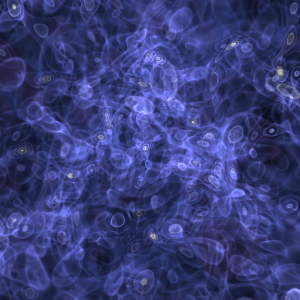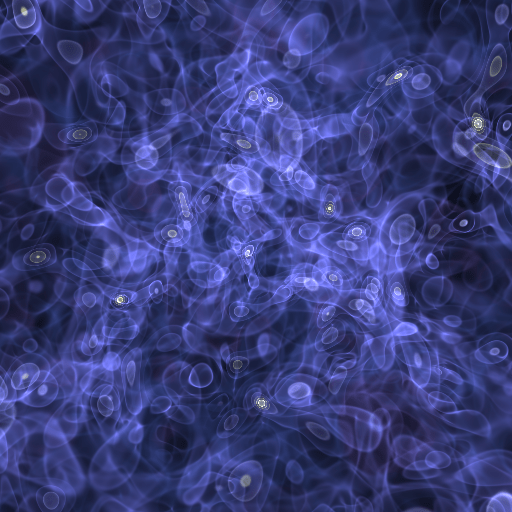If the visible universe starts out at the Planck scale it must have grown larger by at least 60 factors of 10 since the Big Bang. Half of these “decades” of expansion would be accounted for by the hypothetical inflationary phase, a period of accelerated growth that happens in an eye-blink immediately after the Big Bang itself. The next 15 factors of 10 would take a trillionth of a second, while the final 15 factors of 10 require the nearly 14 billion years which elapse between that moment and the present day.

Overdensities in the post-inflationary universe; white regions show locations where the density is 100 times greater than average.
Immediately after inflation the Universe is filled with a mirror-smooth, cold, ultra-dense quantum condensate, a novel state of matter. This condensate must somehow fragment into the contents of the present-day cosmos, a process known as “reheating”. Particle interactions would happen at energies far beyond the reach of our current knowledge of high energy physics as inflation ends. However, interaction energies decrease as the Universe expands and are expected to drop to a level at which the so-called Standard Model is applicable roughly a trillionth of a second after the Big Bang.
This unknown epoch is sometimes called the primordial dark age. When it commences the Universe is governed by rules we do not understand and contains no light or radiation but it can account for half of the total (logarithmic) growth of the post-inflationary universe. This phase is critical to understanding the full history of the Universe and may hold clues to the origin of the dark matter and excess of matter over antimatter that characterises the present-day Universe.
The idea of inflation is now forty years old and many of its key predictions have been verified observationally. However, the details of the dark age – which connects inflationary physics to the familiar particles we observe – remains mysterious, even in the simplest inflationary models. Understanding the phenomena that can occur in this epoch has been a long-term interest for Easther.
In 2019, Musoke, Hotchkiss and Easther took a big step forward when they showed that for many simple models the primordial dark age phase is governed by the Schrödinger-Poisson equation, which describes the interaction between non-relativistic quantum matter and its own gravitational field. This insight sets up an analogy between the mathematical description of the growth of galaxies in a universe dominated with “ultralight dark matter”, which is also obeys the Schrödinger-Poisson equation. By a happy coincidence ultralight dark matter was already a separate area of focus for the Auckland group. Consequently, we could adapt tools developed to understand the properties of ultralight dark matter in galaxies to simulate the post-inflationary condensate. What we learn is that small perturbations in the post-inflationary condensate will grow slowly as a result of their own self-gravity and eventually collapse into bound objects.
This parallel between the primordial dark age and the growth of galaxies is a universe dominated by ultralight dark matter is incredibly fruitful, and shows that an analogue of the present-day cosmic web can form during primordial dark age, even though it would “melt” as reheating completes. With Jens Niemeyer, Easther showed that the Press-Schecter formalism, an approximate description of the evolving galaxy population, could be adapted to describe the growth of overdense regions in the primordial dark age. These results were then confirmed with a direct numerical simulations using codes first developed for modelling galaxy formation but which could be quickly adapted to the primordial dark age using both pure N-body techniques and codes that resolved the inner cores of collapsed regions, showing the formation of “inflaton halos” and “inflaton stars”.
We are now working to fully understand this epoch in more complex inflationary models and hope to use this knowledge to build a coherent account of the evolving universe from the Big Bang through to the present day and beyond.
Related Papers
- Stochastic gravitational waves from postinflationary structure formation Benedikt Eggemeier, Jens C. Niemeyer, Karsten Jedamzik and Richard Easther Phys.Rev.D 107 (2023) 4, 043503 • e-Print: 2212.00425 [astro-ph.CO]
- Gravitational collapse in the postinflationary Universe Benedikt Eggemeier, Bodo Schwabe, Jens C. Niemeyer and Richard Easther Phys.Rev.D 105 (2022) 2, 023516 • e-Print: 2110.15109 [astro-ph.CO]
- Formation of inflaton halos after inflation Benedikt Eggemeier, Jens C. Niemeyer, Richard Easther, Phys.Rev.D 103 (2021) 6, 063525 • e-Print 2011.13333 [astro-ph.CO]
- Inflaton clusters and inflaton stars, Jens C. Niemeyer and Richard Easther, JCAP 07 (2020) 030 • e-Print 1911.01661 [astro-ph.CO]
- Lighting the Dark: Evolution of the Postinflationary Universe Nathan Musoke, Shaun Hotchkiss and Richard Easther, Phys. Rev. Lett. 124 (2020) 6, 061301 • e-Print 1909.11678 [astro-ph.CO]
